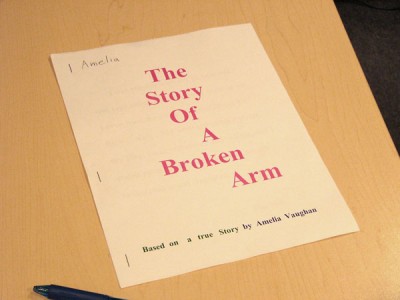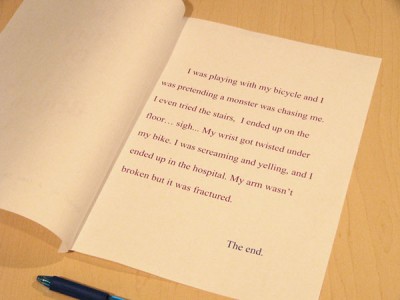Childhood is a time when mysteries loom tall, when the mind is still sorting out what is real about the world, what might be just assumption, and what is outright lie. Childhood memories often betray a fluidity in the nature of reality, and the contrast between imagined dangers and their real consequences is the subject of this remarkable new work by first-time writer Amelia Vaughan.
Part memoir, part roman à clef, The Story of a Broken Arm tells the tale of a childhood accident that left lasting scars on its victim — and for all the brutal caprice of the incident, the account blends poetic questions of causality with meditations on the truth and power of the imagination into a visceral story of survival.
I believe The Story of a Broken Arm was printed only in limited edition, and I was very fortunate to secure an autographed first-run copy direct from the author.
Recently I stopped by my local print shop, DSJ Printing in Santa Monica, to pick up a batch of Machine of Death card games. While my order was being brought out, a tiny hand suddenly popped up from behind the counter and casually placed out a sign: “The Story of a Broken Arm, by Amelia Vaughan. Only $1.99!”
Of course I leapt at the chance. I grew up as a kid running around my parents’ business, amusing myself however I could in stacks of car parts, coming up with weird schemes and cutting up cardboard boxes and bolting together old pieces of junk just to stay sane during the interminable afternoons after school. I am totally, 100% behind any kid-at-the-parents’-work (DSJ has been Vaughan-owned for 55 years) enterprise. I gladly paid my $2, took a polite penny in change, and was pleased to also teach Amelia, who’s maybe about seven, the concept of “autographing your work.”
I didn’t realize it would only be a single page long until after I’d already pre-paid, but what a page it is. Action, pathos, heartbreak, and a bit of ambiguity right at the end as well. Anyway, I consider this an (inflation-adjusted) pay-it-forward for the guy who bought “bitten beans” from me for a dollar, back in about 1994, after I realized that “I SELL BITTEN BEANS” was the only thing I could spell out of a bunch of leftover stickers I found.

(I tell the story of the transaction in Tweet Me Harder 31, and my mom comes on to verify it all in TMH 34.)
The moral is: I started out as a teenager selling dry beans with bite marks. And look at me now! I own my own business where I sell even more ridiculous things. Support entrepreneurial kids, folks!




